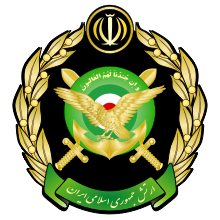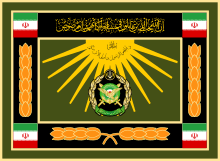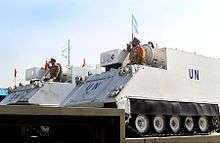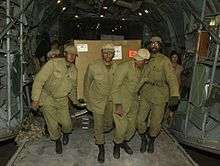Islamic Republic of Iran Army
The Islamic Republic of Iran Army[9] (Persian: ارتش جمهوری اسلامی ایران), acronymed AJA (Persian: آجا), simply known as the Iranian Army or Artesh (Persian: ارتش, romanized: Arteš), is the "conventional military of Iran"[10] and part of Armed Forces of the Islamic Republic of Iran. The army is tasked to protect the territorial integrity of the Iranian state from external and internal threats and to project power.[10] Artesh has its own Joint Staff[7] which coordinates its four separate service branches: Ground Forces, Air Force, Navy and the newly established Air Defense Force.[10]
| Islamic Republic of Iran Army | |
|---|---|
 Seal of the Islamic Republic of Iran Army | |
  Flags of the Islamic Republic of Iran Army | |
| Motto | |
| Founded |
|
| Current form | 1979 (Islamic Republic) |
| Service branches |
|
| Headquarters | Tehran, Iran |
| Website | aja |
| Leadership | |
| Commander-in-Chief | Amir Sarlashkar A. Mousavi |
| Branch Commanders |
|
| Manpower | |
| Military age | 18[6] |
| Conscription | 21 months |
| Active personnel | |
| Expenditures | |
| Budget | $2,036.91 million (1395 SH)[8] |
| Related articles | |
| History |
|
| Ranks | Rank insignia of the Iranian military |
Missions and deployments


The Iranian army has fought against two major invasions in contemporary times. The 1941 invasion by the Allies of World War II resulted in a decisive loss for the Iranian forces, the deposition of Iran's Shah and five years of subsequent occupation,[5] while the 1980 Iraqi invasion began the Iran–Iraq War, which lasted almost eight years and ended in status quo ante bellum. The army has also been actively engaged in quelling tribal and separatist rebellions beginning in the 1940s in order to protect Iran's territorial integrity.[5]
Extraterritorial operations
From 1972 to 1976, Iranian troops were sent to Oman to fight with the Royal Army of Oman against the Dhofar Rebellion.[5] In 1976, a contingent was sent to Pakistan to assist the Pakistan Army against the Insurgency in Balochistan.[5] Iranian personnel were also reportedly present in the Vietnam War.[11] In 2016, members of the Iranian Special Forces were deployed to fight in the Syrian Civil War.[11]
International peacekeeping missions
The Iranian Army participated in UN peacekeeping missions in the 1970s, sending a battalion to replace Peruvian forces in the Golan Heights as part of the Disengagement Observer Force. After the Israeli invasion of Lebanon, the bulk of the forces were part of the Interim Force in Lebanon until late 1978. Replaced by Finnish forces, Iranian peacekeepers were withdrawn in 1979 following the Islamic revolution.[12][13]
In 1993, the Iranian Army reestablished its professional peacekeeping units and declared that they are ready to be dispatched at the UN's directive.[14] Since then, Iran has deployed forces in Ethiopia and Eritrea in 2003 and the African Union Mission in Darfur in 2012.[15]
The Iranian Army's maritime branch has launched several missions to fight piracy off the coast of Somalia,[16] securing the release of many other countries' sailors.[17]
Aid missions
The Iranian Army has deployed forces to help the Red Lion and Sun and Red Crescent societies in rescue and relief missions after domestic natural disasters, including clearing roads, reestablishing communications, supplying goods, airlifting equipment, transporting casualties and personnel and setting up field hospitals and post-hospital care centres.[18][19]
Anniversary
Equipment
See also
References
- "Army Sacrificed for the Nation", Hamshahri (in Persian), 16 April 2008, 48998, retrieved 1 June 2017
- Ward, Steven R. (2014), Immortal, Updated Edition: A Military History of Iran and Its Armed Forces, Georgetown University Press, p. 209, ISBN 9781626160651
- Shahbazi, A. Sh. (August 12, 2011) [December 15, 1986]. "ARMY i. Pre-Islamic Iran". In Yarshater, Ehsan (ed.). Encyclopædia Iranica. 5. Volume II. New York: Bibliotheca Persica Press. pp. 489–499. Retrieved March 15, 2016.
- Cronin, Stephanie (2012), The Making of Modern Iran: State and Society under Riza Shah, 1921-1941, Routledge, pp. 37–38, ISBN 1136026940
- Sheikh-ol-Islami, M. J. (August 12, 2011) [December 15, 1986]. "ARMY v. Pahlavi Period". In Yarshater, Ehsan (ed.). Encyclopædia Iranica. 5. Volume II. New York City: Bibliotheca Persica Press. pp. 508–514. Retrieved March 15, 2016.
- "How I learned to stop worrying and love the Iranian army", Tehran Bureau, The Guardian, 23 July 2015, retrieved 25 October 2017
- Hossein Aryan (November 15, 2011), The Artesh: Iran’s Marginalized and Under-Armed Conventional Military, Middle East Institute, retrieved December 15, 2015
- "Iran decreases IRGC budget for next year". AzerNews Newspaper. 18 January 2016. Retrieved 30 March 2016.
- Army in the Passage of History: Annals, Revolution, the Holy Defense (in Persian). University of Command and Staff. 2012 [1391]. p. 48. ISBN 978-964-2523-38-2.
- Simon, Rita J.; Abdel-Moneim, Mohamed Alaa (2011), A Handbook of Military Conscription and Composition the World Over, Lexington Books, pp. 152–153, ISBN 0739167529
- Qaidaari, Abbas (28 April 2016). "Who sent Iranian Green Berets to Syria?". Al-Monitor. Archived from the original on 2016-05-02. Retrieved 29 April 2016.
- Mays, Terry M. (2010), Historical Dictionary of Multinational Peacekeeping, Historical Dictionaries of International Organizations, 29, Scarecrow Press, p. 279, ISBN 0810875160
- Iran: Country Study Guide, World Country Study Guide Library, 78, Int'l Business Publications, 2005, p. 141, ISBN 0739714767
- "Iranian Peacekeepers Ready to Serve UN Missions, Anytime, Anywhere—Army Colonel". United Nations Information Centre - Tehran. 26 May 2015. Retrieved 25 April 2016.
- "Iran peacekeepers deployed in Darfur". Press TV. 21 April 2012. Retrieved 25 April 2016.
- Wilkin, Sam (8 April 2015). Pomeroy, Robin (ed.). "Iran deploys warships off Yemen's coast". Reuters. Retrieved 25 April 2016.
- Wilkin, Sam (7 January 2012). Pomeroy, Robin (ed.). "US navy frees Iranians held by pirates". Al Jazeera. Retrieved 25 April 2016.
- Razani, Reza (1973), The Engineering Aspects of the Qir Earthquake of 10 April 1972 in Southern Iran: A Report to the National Science Foundation, National Academies, p. 141
- Abolghasemi, Hassan; Poorheidari, Gholamreza; Mehrabi, Ali; Foroutan, Ghasem (October 2005), "Iranian military forces in the Bam earthquake", Military Medicine, 170 (10): 859
External links
| Wikimedia Commons has media related to Army of Iran. |